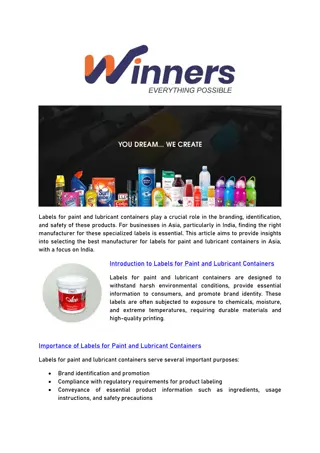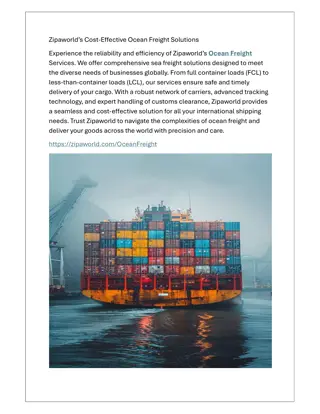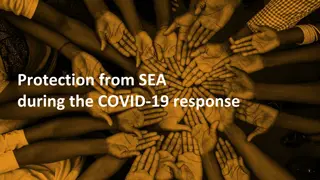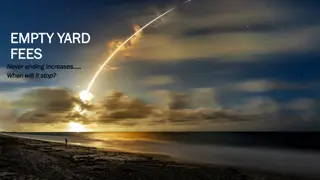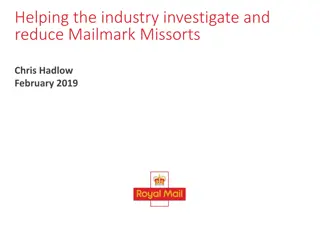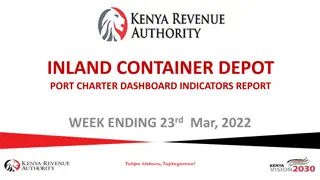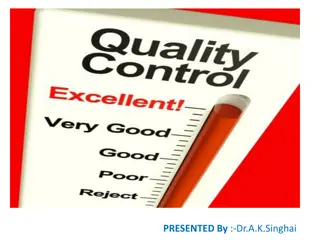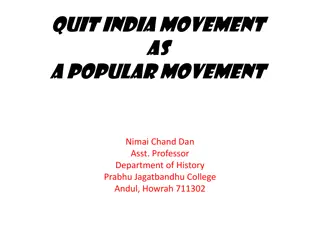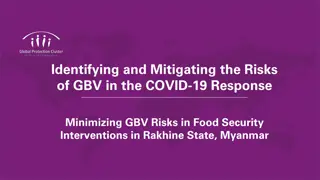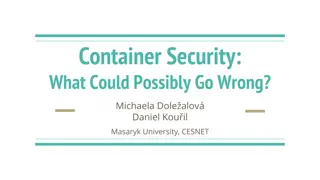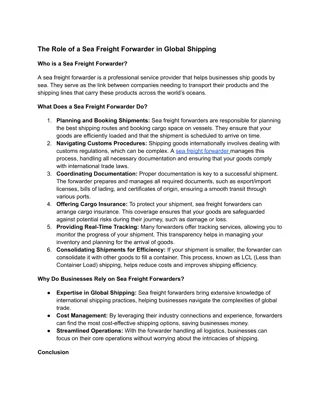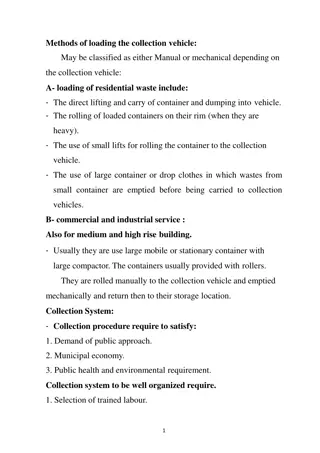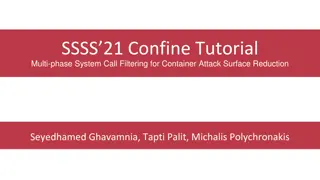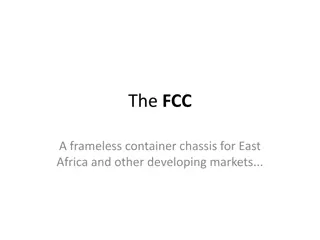Risks and Best Practices in Sea Container Movement
Risks associated with the movement of sea containers and their cargoes, including potential pest pathways and the need for joint actions among stakeholders. Understanding factors such as cleanliness checks, complex container flows, import/export perceptions, and the importance of following the IMO/ILO/UNECE Code of Practice for Packing of Cargo Transport Units (CTU Code).
Download Presentation

Please find below an Image/Link to download the presentation.
The content on the website is provided AS IS for your information and personal use only. It may not be sold, licensed, or shared on other websites without obtaining consent from the author.If you encounter any issues during the download, it is possible that the publisher has removed the file from their server.
You are allowed to download the files provided on this website for personal or commercial use, subject to the condition that they are used lawfully. All files are the property of their respective owners.
The content on the website is provided AS IS for your information and personal use only. It may not be sold, licensed, or shared on other websites without obtaining consent from the author.
E N D
Presentation Transcript
Sea Containers Task Force Update IPPC Secretariat
Risks Associated with Movement of Sea Containers and their Cargoes Sea containers (Cargo Transport Units (CTUs))and their cargoes potential pest pathway High level of risk - once introduced, pests are very difficult and expensive to control or eradicate Involvement of different stakeholders in the supply chain for cooperation Joint actions are needed
Factors to be Understood The movement of sea containers Where sea containers can be checked for cleanliness and cleaned if necessary Joint actions are needed
Sea Container Flows Sea Container flows can be complex may involve multiple transport modes and border crossings, multiple actors and control points Key to following slides: Container Depot Container Terminal Pack or Unpack location Container Vessel
Perception Imports match demand for Exports Balanced Export/Import Countries Container flow - Shipping company ideal Import/Export Countries Empty Full
Imports less than Exports Demand Imports more than Exports Surplus Surplus Locations Container flow The reality Demand locations Empty Full
Sea Container Flows Summary Container flows are complex, involve multiple transport modes, border crossings, actors and control points Empty containers despatched from a repair (or container) depot under the control of a shipping company should be clean. However not all containers pass through a repair (or container) depot Pack points are the most likely points for contamination BUT Shipping companies have no control over these The CTU code is directed at the shipper and packer (pack points)
IMO/ILO/UNECE Code of Practice for Packing of Cargo Transport Units (CTU Code) Produced by : International Maritime Organization (IMO) International Labour Organization (ILO) The United Nations Economic Commission for Europe (UNECE) In cooperation with industry Approved in 2014 A voluntary instrument, a best practice guide, with no mandatory requirements.
IPPC and CTU Code The most important paragraph in the CTU code relevant to the IPPC community: all persons involved in the movement of CTUs also have a duty to ensure, in accordance with their roles and responsibilities in the supply chain, that the CTU is not infested with plants, plant products, insects or other animals. CPM-10 (2015) Recommendation: Sea containers (R-06) The packing of sea containers with cargo is the most likely stage in the sea container supply chain at which sea contamination can occur
Joint Industry Guidelines for Cleaning of Containers Produced by: World Shipping Council (WSC) Institute of Container Lessors (IICL) Container Owners Association (COA) International Cargo Handling Coordination Association (ICHCA) Purpose is to assists in minimizing the movement of pests by sea containers and their cargoes Complementary to the guidance given in the CTU Code Apply when the container is in the container operator s direct control i.e. is in a container depot
Joint Industry Guidelines Any empty container used for the carriage of dry, special or reefer cargo should, when dispatched from a container depot under the control of the shipping company, be clean . Clean means that the empty container s exterior and interior and, for reefer containers, ventilation inlet grilles and floor drain holes, should, at the time of dispatch, have no visible presence of any of the following: Soil Plants/plant products/plant debris Seeds Moths, Wasps, Bees Snails, Slugs, Ants, Spiders Mould and Fungi Frass (insect and bird droppings or waste) Egg sacs Animals, animal parts/ blood/excreta and reproductive components or parts thereof Other contamination that shows visible signs of harbouring pests.
Joint Industry Guidelines contd Contain recommendations on cleaning methods for various types of visible pest contamination. In cases of doubt, local National Plant Protection Office or Quarantine Office should be contacted. Do not replace local regulatory pest contamination measures and requirements. Do not replace individual container operators cleaning guidelines. Are additional to industry guidelines regarding non-pest contamination of containers.
Sea Containers Task Force (SCTF) The SCTF is an IC Sub-group The SCTF purpose is to supervise and direct the implementation of the Sea Containers Complementary Action Plan endorsed by CPM 12, overseen by the IC The SCTF will operate for a temporary period, at the latest until CPM-16 in 2021
SCTF Key Tasks 1. Measuring the impact of the CTU Code by: The development of a joint IPPC/IMO/Industry protocol for the collection of data related to contamination of sea containers Monitoring the uptake and implementation of the CTU Code Verifying the efficacy of the CTU Code in ensuring the arrival of clean sea container
SCTF Key Tasks contd. 2. Increasing awareness of pest risks of sea containers through: Publication of the data of the (previous) Sea Container EWG Requesting countries that have data on contamination to make it publicly available Calling for and publication of pest risk management guidance material for sea containers Encouraging NPPOs to inform industry on the risks and possible international actions to manage pest risks associated with sea containers
SCTF Key Tasks contd. 3. Providing information on pest risks of sea containers and their management 4. Coordinating with contracting parties, regional plant protection organizations (RPPOs), industry and other international organizations 5. Establishing a mechanism for contracting parties to report to Commission on Phytosanitary Measures (CPM) on their progress and achievements 6. Providing advice on how the Cargo Transport Unit (CTU) Code or any other instrument could be updated.
SCTF ongoing actions Monitoring uptake and efficacy of the CTU Code Sea container cleanliness surveys performed by NPPOs Industry monitoring of contaminated containers Engage industry at various forums Industry cleaning guidelines revision (e.g. Institute of International Container Lessors (IICL)) Questionnaire to determine regulatory basis for NPPO container monitoring
SCTF ongoing actions Communication/Increasing Awareness Guidelines on sea container surveys for NPPOs Encourage best practice sharing Use of social media Factsheets
SCTF ongoing actions Communication/Increasing Awareness (continued) Donor agency support pilot for developing countries where there is no legal basis for the NPPO to determine what liaison is required with various entities e.g. customs etc. Encourage national compliance with IPPC framework and CTU Code guidelines.
Contacts IPPC Secretariat Food and Agriculture Organization of the United Nations Viale delle Terme di Caracalla, 00153 Rome, Italy Tel.: +39-0657054812 Email: IPPC@fao.org Websites: www.fao.org www.ippc.int Risultati immagini per youtube Risultati immagini per linkedin button Risultati immagini per twitter Risultati immagini per facebook button






 undefined
undefined



